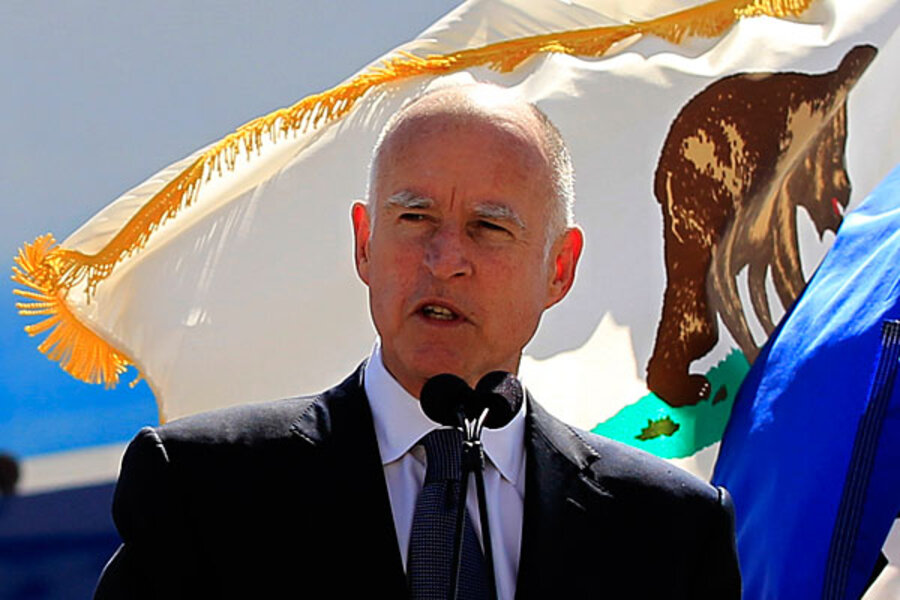Tax the rich ... more? Why Jerry Brown changed his plan to save California.
Loading...
| Los Angeles
California Gov. Jerry Brown (D) is willing to ratchet up taxes on the rich in order to ensure that his top political priority – a ballot initiative to help pare back California’s $9.2 billion deficit – has a better chance of passing this fall.
The move is a nod to political reality. The California Federation of Teachers (CFT) was planning to put its own tax measures on the ballot to compete with Governor Brown’s, and voters typically vote “no” when confused by multiple initiatives on the same topic. So in a deal with the union this week, Brown agreed to amend his plan, making it tougher on California’s wealthiest residents.
Brown’s willingness to change his plan is evidence of how deeply the initiative process has reshaped the political landscape in California. With the Republican minority refusing to play ball in the Legislature, the ballot was Brown’s last resort for his tax plan – and with the teacher’s union threatening to play spoiler, Brown had little choice but to compromise, experts say.
“The initiative system shifts a lot of power from elected officials to those who can mount initiative campaigns,” says Jack Pitney, a political scientist at Claremont McKenna College, via e-mail. “Brown didn't have much leverage over the union. The union had a great deal of leverage over Brown.”
Brown unveiled his original initiative in December, asking voters to approve a half-cent increase in the sales tax and income-tax hikes for the rich – 1 percentage point for earners over $250,000 and 2 points for single earners over $500,000. He told voters that the initiative was crucial to help solve California’s chronic fiscal crises.
To fend off the CFT, however, Brown now says that he is lowering the sales tax hike to a quarter cent and increasing his tax hike on the wealthy – to 2 percentage points on single earners over $300,000 and 3 points for those over $500,000. The tax increases on the rich would also last for seven years, not five, as was the case in the original plan.
“This united effort makes victory more likely and will go a long way toward balancing our budget and protecting our schools, universities, and public safety,” Brown said in a statement.
Democrats across the country could try to copy the idea.
“Brown’s agreement with the CFT constitutes an approach that is seductive for many Democratic politicians,” says Steven Schier, a political scientist at Carleton College in Northfield, Minn. “By raising taxes on the highest incomes, the state gets additional – but highly unstable – source of revenue without stressing the middle and working classes.”
But he questions whether Brown’s initiative will be enough. “California’s budget problems are so severe that it’s just a matter of time before state government must again, with higher taxes, tap its largest, most stable revenue source: middle-class citizens.”
Others agree that taxing the rich might not yield what Brown wants.
“Especially at the high income level, people who work in California can establish residency in a low-tax state,” says Peter Zaleski, a professor at the Villanova School of Business in Philadelphia, in an e-mail. “If higher tax rates on high-income earners was the solution to a budget deficit, then between Hollywood and Silicon Valley, California would not be in the red.” [Editor's note: Mr. Zaleski's name was misspelled in the original version of this paragraph.]
Getting CFT’s measure of the ballot will help clear the field for Brown’s initiative, experts agree. But Brown risks kindling a rich-voter revolt.
“Governor Brown's deal makes it much more likely there will only be one or two tax proposals on the fall ballot, says Michael Shires, professor of public policy at Pepperdine University, via e-mail. But “the expansion of the upper brackets in his proposal may well motivate those affected to fight it even harder.”
Republicans criticized the “closed-door deal.”
“Public opinion polls have already shown that the more voters know about the Governor’s tax hikes, the less they like them,” said Assembly Republican Leader Connie Conway in a statement. “I believe voters will see through this new sham of a proposal.”







